 The large electric sign that rose above Clune’s Broadway once read “The Time, the Place.”
The large electric sign that rose above Clune’s Broadway once read “The Time, the Place.”
Opened in 1910, Clune’s Broadway was one of the first two theatres built on Broadway in Downtown Los Angeles.
The Los Angeles Times described the theatre as “handsome” and “elaborate” upon its opening. Clune’s Broadway, which was also known as the Cameo Theatre, was built to be a “picture playhouse,” and that was what it remained during its 81-year-run as an operating movie theatre.
Today, Clune’s Broadway is no longer the “time” or the “place.” In fact, it is no longer a theatre. The seats are removed, the molding crumbled and the interior littered with boxes and unsold electronics.
Clune’s Broadway stands in the heart of Los Angeles’ historic Theatre District. The district is home to 12 theaters, many of which are shells of their former selves. The majestic buildings once awaited hoards of theatre-goers. Now, they prove mere interruptions to a landscape of magazine vendors, second-hand watch stores and lingerie shops.
“Broadway’s been a neglected corridor for many years,” said Jessica Wethington Mclean, the coordinator for Bringing Back Broadway.
 For that reason, both the City of Los Angeles and the Los Angeles Conservancy passed initiatives to “bring back Broadway.”
For that reason, both the City of Los Angeles and the Los Angeles Conservancy passed initiatives to “bring back Broadway.”
In 2008, Los Angeles City Councilmember José Huizar enacted the 10-year Bringing Back Broadway plan, which seeks to repair broken sidewalks, increase parking options and attract more private business to the district. Seeing the Theatre District—often referred to as the “birthplace of entertainment”—in disuse and disrepair, Huizar felt strongly that city-sponsored preservation and revitalization efforts were necessary.
“He spent a lot of time there as a kid and he remembers how important Broadway is to the city,” said Mclean. “He really wants to do everything he can to make sure the corridor gets the attention it needs to make sure his children and their children can enjoy it.”
While vendors occupy several of the storefronts along Broadway—though Mclean said there is a 20 percent vacancy rate on the ground level—1 to 2 million square feet of commercial space on the upper floors are vacant. The goal of Bringing Back Broadway is to fill that space.
“Once the city steps in and really pays attention to the corridor, making it nice, making it viable in the public right of way, when that all starts to really work, it makes private investment make a whole lot more sense,” said Mclean.
The plan, which Mclean emphasized requires public and private partnerships, also applies to the street’s theatres. Mclean said the owners of the Los Angeles and the Palace theatres have issued letters of intent to restore the theatres as entertainment venues if the city complies in providing more parking and loading zones.
 While the City of Los Angeles has focused its efforts on making the district appealing to investors, the Los Angeles Conservancy has worked to promote the restoration of its 12 theatres.
While the City of Los Angeles has focused its efforts on making the district appealing to investors, the Los Angeles Conservancy has worked to promote the restoration of its 12 theatres.
In 1999, the Conservancy set its preservation sights on Broadway.
“It was still a vibrant area—there was a big vibrant shopping district in the 90s—by day, but at night it was totally shuttered,” said Cindy Olnick, the director of Communications at the Los Angeles Conservancy. “So, we thought what could we do to bring Broadway back to the vibrant 24-hour urban community that it was in the day.”
As part of the Broadway initiative, the Conservancy began hosting and advertising entertainment programs in the theatres on Broadway. One of its series, the weeklong classic movie festival Last Remaining Seats is sold out every year.
“Once people see the theatres for themselves, they can’t help but want to preserve them,” said Olnick. “We want to create the constituency and the awareness that the theatres are still there, they are still viable and they just need some programming to get them started.”
 The Broadway initiative also drafted construction guidelines for the historic buildings in the Theatre District.
The Broadway initiative also drafted construction guidelines for the historic buildings in the Theatre District.
Both the Broadway initiative and Bringing Back Broadway promote the use of the theatres for other purposes—while maintaining their original structures, of course.
Loew’s State, once the most profitable theatre on Broadway, is now a Spanish-language church. The Warner Bros. Theatre now houses a jewelry mart.
“In a perfect world, it would be great to have these things used for their intended purpose,” said Olnick. “But the fact is that times change, people’s needs change and the needs of the community change.”
John Ghini, a docent on the Conservancy’s Theatre District tour, said that he hoped that, with the efforts of the city and the Conservancy, the Theatre District would achieve its former glory in the next decade.
“In its height there were 17,000 people in the theatres, if the theatres were full, there were dance halls, there were restaurants,” said Ghini. “This place was really alive. It had vibrance, and these theatres helped do that.”
While vibrance is the long-term goal, Broadway activists are now working on filling the vacant, fixing the broken and preserving the old.
“Whatever keeps the theatres standing is what we’re for,” said Olnick. “Whatever keeps them standing and well cared for and preserved.”
Jury finds in favor of police officer in South L.A. wrongful death case
After two hours of deliberation, a jury found in favor of a Los Angeles police officer in a wrongful death case brought by the wife of a man killed in the Crenshaw area Monday.
Laura Michelle Cox, a Woodland Hills resident, sued Officer Jose Campos for excessive force in the shooting of her husband Maurice Cox on March 1, 2008.
“I’m in total shock,” Cox said of the verdict and how quickly it was reached, according to City News Service.
Cox argued that the 13 shots fired at her husband were excessive because the object in his hand that the officers perceived to be a weapon was, in fact, a cell phone.
But the 9-3 verdict found against her.
“I’m totally relieved,’” said Campos, a 10-year veteran of the Los Angeles Police Department, according to City News Service. “We’re out there to protect the public and to do the right thing.”
Cox said she and her lawyers are investigating a possible appeal.
Maurice Cox was killed after crashing his truck near Crenshaw Boulevard on a night his wife said he had been playing dominoes with friends. Believing Maurice Cox was armed, several officers fired nearly 50 rounds at Maurice Cox, the fatal wound coming from a Los Angeles Police Department officer who was no longer in the case when it went to a jury.
The shooting was captured on film by Alex Alonso of streetgangs.com and a service station security camera.
The District Attorney’s office investigated the shooting but decided against prosecuting the officers involved.
Photo courtesy of Creative Commons
Union Rescue Mission serves thousands at Thanksgiving feast
The Rev. Andy Bales speaks about the Thanksgiving Celebration at the Union Rescue Mission.
When asked what brought him to the Union Rescue Mission on Skid Row, the Rev. Andy Bales recalled a sermon he gave 24 years ago.
“I preached a sermon about how important it is to feed people who are hungry and not turn your back on people who are hungry,” said Bales. “If you turn your back on people who are hungry, it’s like turning your back on God himself.
“And I preached that six times, and then on a weekend, I had a man ask me for my lunch and I turned him down. I realized that I was not practicing what I preached.”
So, in the spirit of “practicing what he preached,” Bales went to work at a downtown rescue mission, ultimately ending up at the Union Rescue Mission on San Pedro Street.
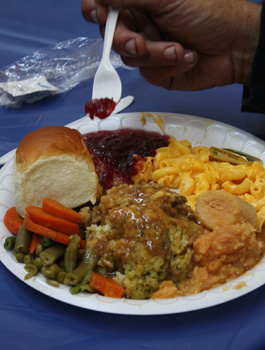 And on Saturday afternoon, Bales joined 300 volunteers in providing a Thanksgiving meal to an estimated 3,500 of Skid Row’s hungry.
And on Saturday afternoon, Bales joined 300 volunteers in providing a Thanksgiving meal to an estimated 3,500 of Skid Row’s hungry.
The mission’s Thanksgiving Celebration, co-sponsored by the daytime drama The Bold and the Beautiful, is its largest food event of the year.
Among event volunteers were cast members from The Bold and the Beautiful, Los Angeles City Councilwoman Jan Perry and Paris Hilton, who Public Relations Specialist Kitty Davis-Walker said often volunteers at the Union Rescue Mission.
Donald Morris, who attended the event, said that the lines weaving up San Pedro Street were so long that he left and came back.
Gobbling down a piece of pumpkin pie next to Morris, Daljit Singh added, “I’ve enjoyed the food, enjoyed the lunch.”
While dishes ranged from stuffing to greens to macaroni and cheese, the highlight of the meal were 160 turkeys, cooked in 15 turkey fryers between the hours of 1 and 11 a.m.
“We’re trying to welcome everyone who’s on Skid Row, who’s experiencing homelessness and welcome them to our house. We welcome them to our house and welcome them to sit down and have a nice Thanksgiving Dinner,” said Bales.
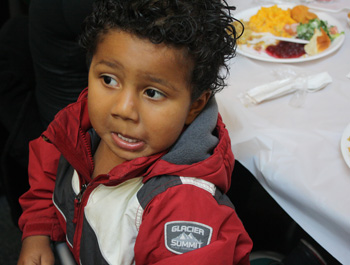 This year’s celebration differed from past ones in its location. Bales said it is usually held on San Pedro Street, but due to inclement weather, the celebration was moved inside.
This year’s celebration differed from past ones in its location. Bales said it is usually held on San Pedro Street, but due to inclement weather, the celebration was moved inside.
“Having to do it inside made us live a little close and see each other a little closer, and so hopefully it built some community today,” he said.
Bales also hopes that the Thanksgiving Celebration will spread awareness about the programs at the Union Rescue Mission. The mission houses men, women and children and offers long-term rehabilitation programs.
The number of people on the streets of Skid Row has decreased from 2,000 to 750, said Bales. But he believes reaching out to the remaining 750 will be a greater challenge.
“They are reluctant to come into a mission. They are suffering physically and mentally and often battling addiction. And so, they need a special way to reach out to them,” said Bales.
For that reason, the mission offers cold water on hot days and extra beds during the winter. It has also partnered with the Chamber of Commerce and the United Way in advocating for the creation of more supportive permanent housing.
And at the Thanksgiving Celebration, it gave the residents of Skid Row a place to escape the rain, grab a meal and maybe more.
“Sometimes, it becomes more than a meal,” said Bales. “They may decide to make a change, come in and enroll in one of our programs and give life one more try.”
Survey finds South L.A. voters favor Democrats, marijuana
 The midterm elections marked a new era in the governing of the state of California. In South Los Angeles, that change was not ushered in at glamorous campaign parties but instead in quiet lines at the area’s hundreds of polling places.
The midterm elections marked a new era in the governing of the state of California. In South Los Angeles, that change was not ushered in at glamorous campaign parties but instead in quiet lines at the area’s hundreds of polling places.
The race for Governor, Senator and Attorney General were on the ballot, as were the controversial Propositions 19 and 23.
In an area with historically low voter turnout, poll workers noticed unusually high turnouts. Ana Garcia, a poll worker at the Walker Temple African Methodist Episcopal Church in South Central, said their polling place had been busy all day.
For residents like Rodney Askew, heading to the polls was a “civic duty.”
“It’s voting day,” he said, beaming after voting at F. Griffith Joyner Elementary School in Watts. “Get your vote on.”
And South Los Angeles did “get its vote on”—Democratically, that is.
According to an exit poll survey conducted by the reporting team at The South Los Angeles Report, the majority of the South Los Angeles community voted for Democratic candidates.
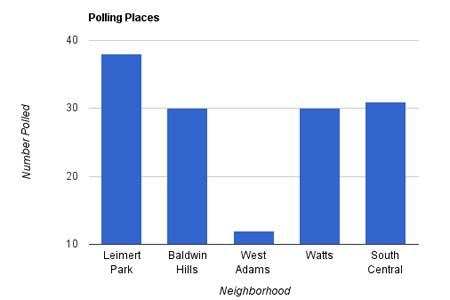
Gubernatorial candidate Jerry Brown was the overwhelming favorite of the day, garnering 127 of 141 voters polled, an astonishing 92.7 percent.
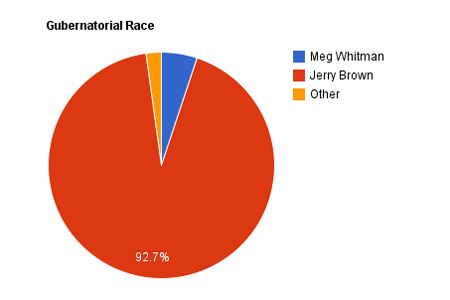
“California hasn’t been stable in about eight years now,” Askew said. “So with Brown, he knows how to balance the budget, so it won’t take him too long to balance it. Then, people can get save their jobs and they won’t have to cut too much funding.”
For Leimert Park voter Oneil, the vote for Brown was mainly a vote against his opponent Meg Whitman.
“I don’t usually vote,” Oneil said. “But this time I had to get out and make a difference. Whitman hates unions, and I’ve got a union job with the MTA [Metropolitan Transportation Authority].”
 A similar breakdown was seen in the Senate race between Barbara Boxer and Carly Fiorina. Boxer, who has already served three terms in the Senate, won 91 percent of the voters polled in South Los Angeles.
A similar breakdown was seen in the Senate race between Barbara Boxer and Carly Fiorina. Boxer, who has already served three terms in the Senate, won 91 percent of the voters polled in South Los Angeles.
Isaid Nieto, one of the few Republicans encountered at South Los Angeles polls, said he respected Boxer’s efforts.
“But she has to take some time to relax,” Nieto said.
While there was still a Democratic majority, the votes for Attorney General were more balanced.
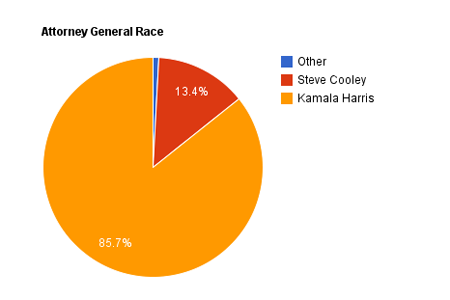
Democrat Kamala Harris, who spent Sunday morning in South Los Angeles speaking in six area churches, favors the environment and prison reform. She is also vehemently against the death penalty. Harris received 85.7 percent of the exit poll survey’s vote.
Steve Cooley, her Republican opponent, supports the death penalty. He claims to support what voters pass into law. The voters polled gave him 13.4 percent of their votes.
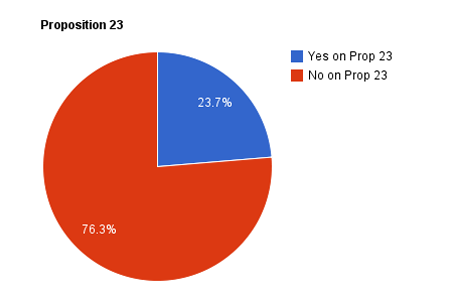 The Proposition races proved more heated. Proposition 23 suspends Assembly Bill 32, which enacts caps on carbon emissions, in favoring of lowering the unemployment rate.
The Proposition races proved more heated. Proposition 23 suspends Assembly Bill 32, which enacts caps on carbon emissions, in favoring of lowering the unemployment rate.
Jamie Aguilar, a 19-year-old resident of South Central, called Assembly Bill 32 a “a valuable and effective law” and he said that with the current economy, the Proposition’s goal of achieving 5.5 percent unemployment is “impossible.”
Hiram Grisson, a fellow South Central resident, agreed. “We need clean air. Companies go to the extreme.”
A majority of 76.3 percent voted “no” on Proposition 23.
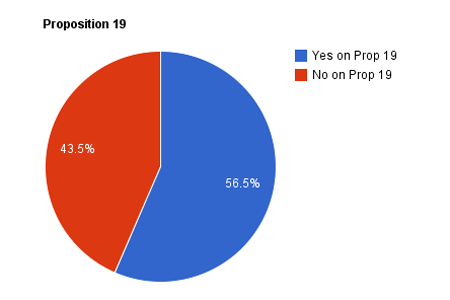 The much-debated Proposition 19 saw a smaller margin. In the South Los Angeles Report survey, a slight majority (56.5 percent) voted “yes” on Proposition 19.
The much-debated Proposition 19 saw a smaller margin. In the South Los Angeles Report survey, a slight majority (56.5 percent) voted “yes” on Proposition 19.
“When something’s prohibited, people want to use it more,” said Ana Gonzalez, a South Central resident who voted for primarily Green Party candidates.
Another Green Party voter went to the polls with her mother and voted “yes” on Proposition 19. After saying she voted for all the Green Party candidates, she quickly added, “But please, don’t tell my mother.”
One voter in Leimert Park said that she voted for Meg Whitman even though she did not care about the gubernatorial race. She just wanted to get down her ballot quickly so she could vote “yes” on Proposition 19.
Askew, however, was among the opponents of what is known as the “Pot Proposition.”
“If you legalize marijuana that’s going to make things like drunk driving happen. It’s crazy. That’s a no brainer,” Askew said.
First-time voter Luciano Morales had his sister draft a “how-to-vote cheat sheet” for the election, but Proposition 19 was not something on which he needed guidance.
“Why would I want it to become legal? I’m thinking about future generations,” Morales said. “I believe it’s not right. It’s going to affect the kids.”
The future was on the minds of many South Los Angeles voters as they drove to the polls, stood patiently in lines and marked their ballots.
Some came with clear choices emblazoned in their minds, and others, like Blanca Camacho “just voted for whatever.”
Many voted on party lines. Some even had guides on how to vote produced by organizations like the NAACP.
But, overwhelmingly, the sense at South Los Angeles polls was that voters felt honored to participate in the political process.
“We did our patriotic duty,” South Central resident Paul Thornhill told his son as they exited the polling place.
Reporters Raquel Estupinan, Emily Frost, Emily Henry, Kaitlin Parker and Christine Trang contributed to this report.
Crenshaw celebrates Taste of Soul Festival
The 5th Annual Taste of Soul Festival livened up Crenshaw Boulevard with soul food and soulful music. The event was presented by the Los Angeles Sentinel Newspaper and Mothers in Action, in conjunction with Radio Free 102.3 KJLH and the 94.7 The Wave.
An estimated 100,000 people attended the event, which monopolized Crenshaw Boulevard from Martin Luther King Jr. Boulevard to Rodeo Boulevard.
Food options included fried chicken, pulled pork, corn on the cob and pecan pie. Beyond the soul food, the festival boasted several performance acts and informational booths.
Churches join together to host fall festival
The Pilgrim Missionary Baptist Church and the Church of Jesus Christ of Latter-Day Saints are co-sponsoring a fall festival and gospel music festival on October 23 and 24 at the Pilgrim Missionary Baptist Church near Vernon and Central.
Volunteers from both churches work together under a coalition called One Heart Many Hands L.A.
The coalition was spearheaded by Dr. Albert Nicholas, the Senior Pastor at the Pilgrim Missionary Baptist Church, and Robert Keeler, the president of the Santa Monica Stake of the Latter-Day Saints Church. It seeks to host joint community service, musical and multi-faith events.
One Heart Many Hands L.A. has worked extensively in the South Los Angeles community providing tutoring to high school students and college preparation workshops.
Congregants of Nicholas’s church and a single young Mormon branch of the Santa Monica Stake planned the fall festival and concert.
“It’s vital that we reach out to our community and do all we can to lift the people around us,” said Jackie Darby, a member of the Pilgrim Missionary Baptist Church, in a press release.
The fall festival on October 23 will have games, booths and activities, as well as information and workshops regarding health and emergency preparedness.
The following evening, the Southern California Mormon Choir and the Pilgrim’s Combined Choir will fill the Pilgrim Missionary Baptist Church with gospel music.
Admission to both events is free.
“I couldn’t see us leaving the money in the bank when we could use it to help people,” said Bishop Larry Eastland of the Church of Jesus Christ of Latter-Day Saints.
For more information about the fall festival or the One Heart Many Hands L.A. coalition, please visit www.facebook.com/oneheartmanyhandsLA.
Virtual Book Club discusses race and America’s future
Starting in late September, EquityBlog launched the innovative idea of taking discussions of books from the living room or classroom and onto the Internet. The “Race and America’s Future Virtual Book Club” is a six-week long online seminar that provokes conversation about race relations and the concept of a post-racial society.
The book club will focus on the book Uncommon Common Ground: Race and America’s Future. Co-authors Angela Glover Blackwell, Stewart Kwoh and Manuel Pastor will moderate the online discussions.
According to its press release, the club “will host an online conversation looking at crucial issues facing America as we push toward 2050 and our inevitable future as a nation with no majority ethnic or racial group.”
Upcoming topics include:
- Oct. 6: Color Lines: Growing and Accepting Diversity
- Oct. 13: Race and the Economy
- Oct. 20: Urgent Challenges: Immigration, Incarceration, and Climate Change
- Oct. 27: New Leadership for now and 2050
- Nov. 3: Equity is the Superior Growth Model
To find out more about the “Race and America’s Future Virtual Book Club,” go to www.equityblog.org.
Learn more about the idea of a post-racial society.
Flower Market brings color to Downtown L.A.
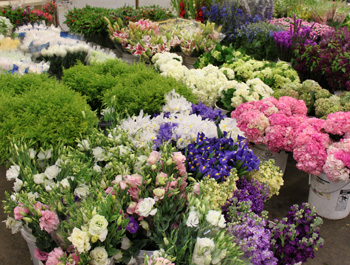 A little after midnight, a shipment of baby’s breath arrived at the Los Angeles Flower Market.
A little after midnight, a shipment of baby’s breath arrived at the Los Angeles Flower Market.
It was not an unusual occurrence. In fact, that shipment arrived at that time each week. But the employees who unloaded the hundreds of bushels from the unmarked truck parked conspicuously on a deserted Wall Street did so with a sense of urgency.
Hastily thrown on a rusted metal cart, the flowers were wheeled into the market. With blue painter’s buckets as vases, the baby’s breath was quickly arranged on the market’s floor.
The baby’s breath—along with the tulips, roses and hydrangeas that resided in its immediate area—would be arranged once more before the sun came up, and again later that morning when the public gained admittance to the market at 8 am.
Pat Dahlson watched the flowers come off the truck and complete their journey to the concrete floor. It had been a long journey. The baby’s breath came from Columbia, he suspected. The orders for his stand did at least.
Dahlson drank coffee out of a Styrofoam cup, and as the clock neared 3 am, he offered it generously.
“It’s late,” he agreed, shrugging his shoulders, a veteran who had seen many a night shift reach the morning light.
Thirty-two years ago, Dahlson’s parents opened a wholesale flower stand at the Los Angeles Flower Market.
The Los Angeles Flower Market and the Southern California Flower Market house about 200 vendors within the two blocks now referred to as the Flower District.
“I’ve been here everyday for those 32 years,” Dahlson joked.
Mayesh Wholesale Florists Inc. was a family business, and it was as a family business that it grew and expanded. The company now has 17 locations in seven states. It also now employs Dahlson and all of his eight siblings.
“It’s the beauty,” said Dahlson, now the CEO of the company. “The business gets to you. It grows in your blood.”
* * *
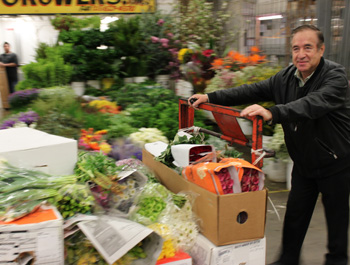 Mayesh Whole Florists Inc. specializes in high-end flowers, which Dahlson aptly described as “stuff grown in different parts of the world.”
Mayesh Whole Florists Inc. specializes in high-end flowers, which Dahlson aptly described as “stuff grown in different parts of the world.”
While Dahlson claims the niche for exotic flowers in the market, importing is not a unique concept in the Flower District.
The district welcomes flowers from six continents daily.
“The flower market is completely different,” said longtime florist Chik Furuta. “In the old days, you used to have a lot of growers of domestic flowers. Now, 70 to 85 percent of the flowers are import flowers.”
Furuta travels to the district twice a week from Fountain Valley, Calif. to save 30 percent on his flower purchases.
“The cost of doing business in the U.S. is high, so they save money by importing,” Furuta said.
But Dahlson said that importing allows wholesalers the opportunity to do more than simply offer the lowest price.
“Importing has allowed us to have products at times of year when they didn’t exist before,” said Dahlson. “In years past when we relied only on California, you wouldn’t see the expanse of variety that we have any day of the week now because we’re searching around the globe for the product.”
Despite the obvious benefits to increased importing, California proves a hospitable environment for floriculture. Once the cut flower supplier to the United States, the state’s warm weather and temperate climate have attracted flower growers for decades.
“The first generation of Japanese-Americans was mostly growers. Italians came over and grew flowers in this region. So, it’s historical in that people grew flowers just like they did at home,” Dahlson said.
Fausto Orellana immigrated to the United States from Ecuador. Forty-five years ago, he moved his family business—the rose business—into the Los Angeles Flower Market.
Orellana imports roses and lilies from Ecuador through family connections for his store called St. Germain Flowers.
“It’s family,” his son Dennis Orellana reasoned, as he removed a recent shipment of pink roses from their boxes. “If you can’t trust your family, who can you trust?”
In fact, the only thing about Orellana’s business that isn’t family oriented is the name.
“My wife had the idea because it’s the saint for French for fate.” Orellana said, laughing. “It’s not really a family name. It’s just a French saint.”
* * *
Lacey Carter perused the plants at The Greenery. Feeling their petals briefly, she quickly jotted down notes on the small pad in her hand.
Dressed casually in a sweatshirt and jeans with her blonde hair tied back, Carter was among the few florists in the market at 2:30 am.
Carter commutes to Los Angeles twice a week from Bakersfield to take advantage of what she called the Flower District’s “good quality for a lot cheaper.”
Because she needs to be back in Bakersfield by 6 am, trips in the wee hours of the morning are a part of her normal routine.
A badge member of the district, Carter can attend the market’s wholesale hours—Monday, Wednesday and Friday from 2 to 8 am. And she always does.
“If you come when it’s open to the public, it’s insanely busy,” said Carter, adding with a shudder, “I’ve come a couple of times, and I’ll never come again.”
Furuta also comes during wholesale hours—and sometimes, before—to get the first pick of the flowers.
“I don’t preorder flowers, so I come and pick out my flowers twice a week,” said Furuta. “I just look for freshness and quality.”
It was that pursuit of “freshness and quality” that transformed a very daytime business—flowers need sun to grow—into an operation run primarily at night.
Before refrigerated trucks increased the shelf life of cut flowers, local growers would grow and cut their flowers during the day and bring them to a central distribution center at night.
“That’s how they did it because of what they had available to them,” said Dahlson.
“But now it only makes sense to stay that way because if we didn’t do distribution to our customers at night, traffic in and out of downtown Los Angeles would be so bad that I don’t know how [customers] would get here.”
“And the hours have evolved,” Dahlson added. “When I first started working years ago, you would see dozens of customers right here going crazy. Today, they’re not going to come until five in the morning.”
* * *
 Dahlson pointed out his niece, as she bustled around the stand collecting flowers. She is a designer for Mayesh Wholesale Florists Inc., a third generation wholesale flower vendor.
Dahlson pointed out his niece, as she bustled around the stand collecting flowers. She is a designer for Mayesh Wholesale Florists Inc., a third generation wholesale flower vendor.
“We grew up in the business and that was the path we took,” he said.
But uncertainty remains as to whether their company will be around to employ a fourth generation.
Cut flowers and blooming plants, an estimated $8 billion industry, have been hit by the recession.
As extravagant events have began to be seen in poor taste, the need for large orders of flowers has dropped significantly. As have the purchase of single bouquets.
“Never before have flowers been viewed as “I can live without them,’” said Dahlson. “It’s a discretionary item so it took a hit.”
Dahlson hopes that the economy will turn around and with it, that people remember what makes flowers so important.
“They’re beautiful,” said Dahlson. “And if things are tough, you bring some flowers home, you put some flowers on the table, and it’s just a really nice way to brighten your day.”










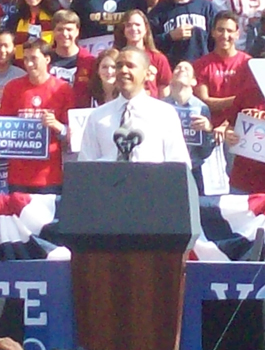 At 2:05 pm on Friday, President Barack Obama stepped to the podium placed on the steps of Doheny Library at the University of Southern California.
At 2:05 pm on Friday, President Barack Obama stepped to the podium placed on the steps of Doheny Library at the University of Southern California. 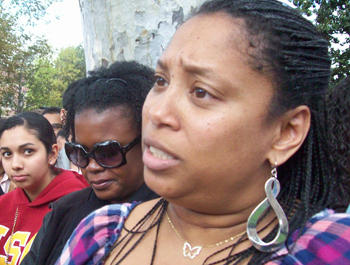 For the majority of the audience, Obama was the big draw to the rally. Supporters were adorned in “Yes We Can” T-shirts and Obama blankets.
For the majority of the audience, Obama was the big draw to the rally. Supporters were adorned in “Yes We Can” T-shirts and Obama blankets.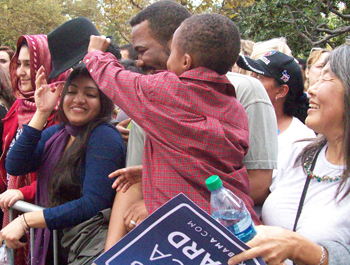 Pilar Posada, a West Covina resident, spoke out against the economic downfall.
Pilar Posada, a West Covina resident, spoke out against the economic downfall.




